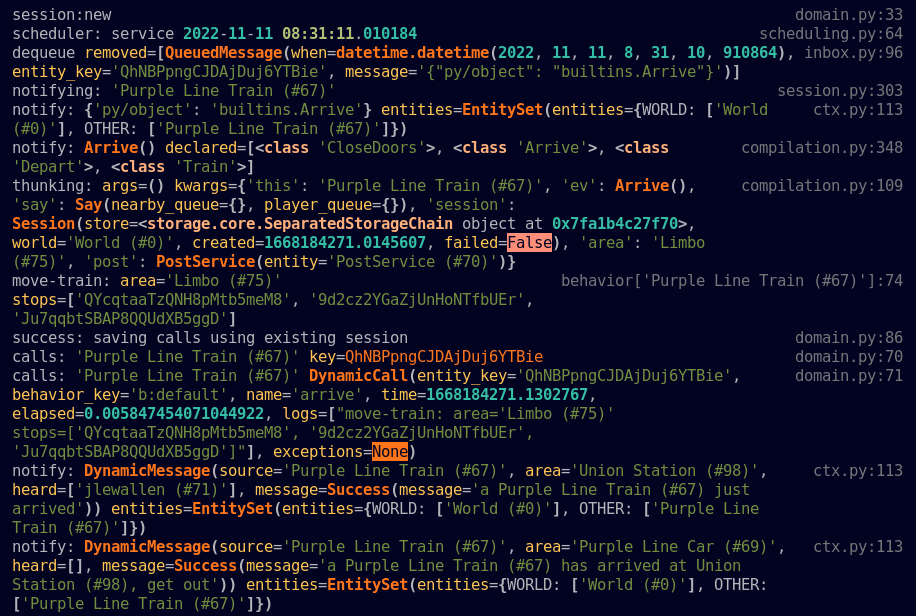My MUDdy Romance
Jacob Lewallen 1032 words 6 min read November 09, 2022 #MUDs #rust #history #programmingMUDs hold a very special place in my heart. If you aren't familiar, a
MUD is a multi-user, networked, text based
virtual world. Navigable via english like commands, go north, very nearly
like moving around the file system in the terminal. Hundreds of interconnected
rooms and areas forming whole towns, forests, caves, dungeons and their
contents. Entire land masses, all cohesively and fluidly described along with
the game specific mechanics and physical objects and characters of the virtual
world. They are amazing monuments to creativity, capable of setting your
imagination free and drawing you in. 1
Unfortunately, my actual experience with them is pretty limited and all begins with GemStone III.

This is the heart of the main square of Wehnimer’s Landing. The impromptu shops of the bazaar are clustered around this central gathering place, where townfolk, travellers, and adventurers meet to talk, conspire or raise expeditions to the far-flung reaches of Elanthia. At the north end of the space, an old well, with moss-covered stones and a craggy roof, is shaded by a strong, robust tree. The oak is tall and straight, and it is apparent that the roots run deep. You also see a copper lockpick, a heavy backpack, a large acorn and some stone benches.
GS3 is a text based fantasy RPG and it was my first and only experience with anything close to a MUD. My family was on Prodigy, and back then all the big services had access to GS3. I wish I could remember how I was introduced to the game. I just remember being obsessed. Thoroughly invested. Staying up late, getting up early and throwing mini LAN parties with my other friend who played. Printed, physical maps. Possibly laminated. I think you understand. 2
Similarly, I don't remember why I stopped playing.
Anyway.
Lately, my side project has been writing a modern MUD engine, of sorts. It's written in Python and is called dimsum. Its focus is on delivering a "rich-text" experience over the web, with the ability to fall back on something more traditional. It's been a great project and I'm proud of the work in that repository.

Which brings me to the purpose of this post.
My first real rust project is a port of this engine! 😄 In addition to bringing along that feel-good, new project motivation it also feels like a smart project. I'm able to build on top of the architectural lessons I learned with the Python implementation from the beginning and improve many things along the way. It also fits my learning style, which typically involves building a hobby project that in the past, nobody would have seen.
To begin with, it's effectively a language (simple English, to begin with) parser and interpreter for carrying out actions in the virtual world. It requires some interesting borrowing semantics across the domain model and the service layer above where multiple domain objects interact. On top of that is either a Web/RPC API or interactive shell. I also have several features in mind for a kind of federation and linking of "domains" (effectively servers) and the sharing of dynamically created game objects. Oh, and written in the most self-extensible way possible.
Ideally, this is a world that can be used to build itself.
> look
> dig
> go
It's a game that is it's own editor. Not entirely new, actually. There is a deep history of this outside of MUDs/MOOs. Personally, I can only think of LISP REPLs, though I'm sure there are so many more and even earlier examples. At any rate, this doesn't mean that the entire world and it's mechanics need to be written the same way. I'm comfortable with a mixed language approach. I'll be thinking about this as I work on the basics in rust.
I'm going to hold back on a URL, for now. At least until I've settled on a name and have ironed out some organizational things, oh and an easier approach to tests, haha! I would love to have a post describing the architecture, so that'll be the next one I think.
Thanks for stopping by!
Miscellany
There are also MOOs, which are much more like the kinds of things I'm interested in. I believe object-orientated patterns are a great fit here. Sure, there are other patterns you could use. Actor based approaches seem powerful to me, for example but they can usually be thought about in an object-orientated way.
It's hard for me to tell how popular GemStone III still is. I think people may still be playing, or its successor. I'm happy to leave my memories of the game in the past. You can still find artifacts about it online, like the Welcome to the Unofficial GemStone III Page page, or this really great stroll through time, simply titled GemStone III. Oh and this is a great article about the game: Don’t Cry for Me, Elanthia: An Archaeology of Gemstone III which I really, really enjoyed reading and only found while researching this post!